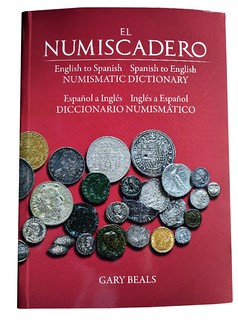
PREV ARTICLE
NEXT ARTICLE
FULL ISSUE
PREV FULL ISSUE
THE MYSTERIES OF MARKETING COIN BOOKS
Author Gary Beals of Segovia, Spain submitted this note on his recent experience marketing his latest book.
-Editor
Nothing. Not a single inquiry about ordering a copy from any member of the American Numismatic Association's 24,000-some collectors and dealers. The only connecting point was my e-mail address at the end of the article, so my first thought was that something was mis-printed on it: Segovia.gary@Yahoo.com — nope, it was just the same address as was using in my mailings between editor Cynthia Wood-Davis and myself. Anyone interested in owning a copy of the book would first need to pop me a short e-mail. Too tough a process? The e-mail was the launching point for new orders: Send me an e-mail and I will send you the payment process with CitiBank via check or direct deposit. Pretty simple — $25 plus $3 postage and handling for a 352-page numismatic dictionary. Provide a mailing address and we will send the book on its way — often even before payment is received. I am quite pleased with the book as a legacy between the 85-page book I produced as a college kid in 1966 and this modern age.
I'm sorry to hear about Gary's experience, but reviews and ads are always a crapshoot. As Philadelphia merchant John Wanamaker is credited with saying, "Half the money I spend on advertising is wasted; the trouble is I don't know which half." I would say that online reviews and ads are better if the only outlet for the product is online. If I read about a Whitman book and later see it in a store or coin shop, I might pick one up. But I might not remember to send an email after I put the physical magazine issue down.
But the book market in general has been changing in many ways in recent years. Gary shared his experience with Dick Johnson, who submitted the following thoughts. -Editor IS THE ERA OF THE BIG NUMISMATIC LIBRARY DEAD? Gary Beals’ lament that his book didn’t sell as expected is evident of the current situation with highly specialized numismatic books. One. The era of the book collector who wants one of every book no longer exists. Two. Modern living does not provide space for a great many book shelves built in a home or office. Three. Organizations, like ANS and ANA, are stressed in their book buying budgets, preferring instead to wait for each new book to be donated, either by the author, or by some benefactor. Gone are the years like in the 18th century where maybe one book of numismatic interest in America was published in a decade. Or in the early 19th century when one or two were published a year, maybe by as many as a dozen by midcentury. Or, say 30 a year after World War II and leisure time gave rise in numismatic activities, including writing and publishing books. Now perhaps 150 new numismatic books are offered every year as specialized interested expands. Gary fell into the trap of ordering too many initial books, 1,000 copies. I admit I did the same with my first book, on artists' monograms. I ordered 300 copies from a regular printer. I sold 50 and now sitting on 250 in storage, knowing that a few will sell a year, for 50 years, hopefully before the copyright expires. There is the allure of a lower unit cost as the volume increases. “The books will cost $2.50 less if you order 500 more copies.” You can hear the printer‘s salesman. The printer makes more money by longer pressruns (at your expense). I am a strong advocate for print-on-demand. I used this for my other two books. Granted you have to do more work. You must do everything in addition to writing -- design the covers, prepare all the illustrations, chose all type faces. You must furnish camera ready copy. You can order any quantity printed. They will even market it for you – to their usual book outlets. You must do specialized marketing yourself. For my second book on American medallists, I omitted their marketing service, but took 100 initial books which I would market myself. I reordered twice after that. At no time did I have more than 50 copies on hand – no storage problem. You must send that camera-ready copy again – but this is good – it gives you a chance to correct any pesky typos and errors. Hints: Hire an editor to check your copy. The editor points out bad writing “delete this,” “rewrite this,” sometimes catches technical errors – worth the cost to have a second pair of eyes. Also recommends eliminating bad features, like a recent book that had the text in changing colors. Just because your computer has dozens of colors available doesn’t mean you have to use them in one book. Another hint: You may also want help in designing the book, both text and covers. I hope I haven’t discouraged anyone from writing a book. If you have formed a collection of some numismatic series or topic, and there is no existing book on that subject, be the first to do so. Good Luck.
Thanks, guys. Reader comments welcome. Meanwhile, for more about Gary's excellent book, see the earlier E-Sylum articles, linked below.
-Editor
To read the earlier E-Sylum articles, see:

Wayne Homren, Editor The Numismatic Bibliomania Society is a non-profit organization promoting numismatic literature. See our web site at coinbooks.org. To submit items for publication in The E-Sylum, write to the Editor at this address: whomren@gmail.com To subscribe go to: https://my.binhost.com/lists/listinfo/esylum All Rights Reserved. NBS Home Page Contact the NBS webmaster 
|
